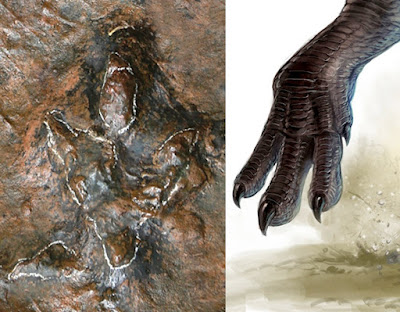 |
| Gigandipus chiappei
Xing, Lockley, Klein, Zeng, Cai, Luo & Li, 2018
|
Highlights
1. First example of a Cretaceous track morphotype attributable to Gigandipus.
2. Second report largest avian theropod tracks Wupus from Lower Cretaceous.
3. The similarity between K1 and J1 theropod ichnotaxa in East Asia.
Abstract
A newly discovered Jiaguan Formation (Lower Cretaceous) tracksite from the Linjiang region of Guizhou Province, China, reveals the first example of a Cretaceous track morphotype attributable to the non-avian theropod ichnogenus Gigandipus, here named Gigandipus chiappei ichnosp nov. The theropod dominated locality also reveals the second report of the avian theropod ichnogenus Wupus, one of the largest avian traces currently known from the Lower Cretaceous. The Linjiang site provides evidence to support previous interpretations of a distinctive Lower Cretaceous theropod-dominated ichnofauna that was widespread in China and East Asia and highlights the similarity between Lower Cretaceous theropod ichnotaxa in East Asia and those found in the Lower Jurassic both in East Asia and elsewhere. These similarities in turn create various ichnotaxonomic challenges familiar to researchers working on theropod tracks, and we recommend caution in the naming of new theropod ichnotaxa at the ichnogenus level.
Keywords: Early Cretaceous; Jiaguan Formation; theropod tracks; Gigandipus; Wupus
Gigandipus tracks
Theropoda Marsh, 1881
Gigandipodidae Lull, 1904
Gigandipus Hitchcock, 1856; Lull, 1904
Type ichnospecies G. caudatus Lull, 1904
Gigandipus chiappei ichnosp. nov.
Etymology. The specific name is in honor of Dr. Luis M. Chiappe, a distinguished paleontologist who is world-renowned on the origin and early evolution birds.
....
Conclusions
The Linjiang tracksite in the Jiaguan Formation of Guizhou Province reveals the first example
of a Cretaceous track morphotype attributable to the non-avian theropod ichnogenus Gigandipus,
here named G. chiappei ichnosp nov. The site also reveals only the second report of the avian
theropod ichnogenus Wupus, which is one of the largest avian traces currently known from the
Lower Cretaceous. The discovery underscores the importance of the Jiaguan Formation as a major
source of tetrapod (theropod) data in the Sichuan Basin region from which little or no useful body
fossil data have been recovered.
Data from the Linjiang site provide growing support for a distinctive and widespread Lower
Cretaceous theropod-dominated ichnofauna in China. This ichnofauna also shows notable
similarities to other Lower Cretaceous theropod dominated ichnofaunas from East Asia, notably
Korea. There are also taxonomically challenging similarities between these Lower Cretaceous
ichnofaunas and those found in the Lower Jurassic both in East Asia and elsewhere. These
challenges, which raise perennial “lumper-splitter” debates, suggest ichnologists should exercise
caution naming new ichnotaxa, especially at the ichnogenus level.
Lida Xing, Martin G. Lockley, Hendrik Klein, Rong Zeng, Sifu Cai, Xiuchun Luo and Chen Li. 2018. Theropod Assemblages and A New Ichnotaxon Gigandipus chiappei ichnosp. nov. from the Jiaguan Formation, Lower Cretaceous of Guizhou Province, China. Geoscience Frontiers. In Press. DOI: 10.1016/j.gsf.2017.12.012




